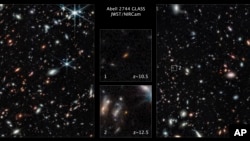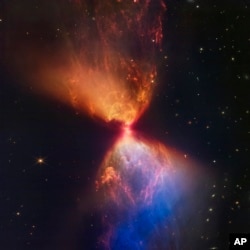NASA’s Webb Space Telescope is finding bright, early galaxies that, until recently, could not be seen. One of these galaxies may have formed only 350 million years after the Big Bang – the event that explains the beginning of the universe.
Researchers said recently that if the results are correct, the newly discovered galaxy could be the most distant one ever identified.
The Webb telescope was launched last December. The recently reported findings suggest that stars may have formed sooner during the formation of the universe than scientists believed. Stars might have formed only a few million years after the Big Bang.
An international team led by Rohan Naidu of the Harvard-Smithsonian Center for Astrophysics detailed the latest findings in the Astrophysical Journal Letters. The report gives more information about two unusually bright galaxies. One is thought to have formed 350 million years after the Big Bang and the other 450 million years after.
Naidu said more observations are needed by the Webb telescope before confirming that a new record has been set.
Some researchers report having found galaxies that formed even closer to the creation of the universe, which is estimated to be 13.8 billion years ago. Those candidates, however, have yet to be confirmed, scientists said at a NASA news conference.
Garth Illingworth of the University of California, Santa Cruz helped write the recent study. Illingworth described the current situation as “a very dynamic time,” meaning a time that is active or changing.
Illingworth added that there have been lots of “announcements of even earlier galaxies, and we’re still trying to sort out as a community which ones of those are likely to be real.”
Tommaso Treu of the University of California, Los Angeles, is a chief scientist for Webb’s early release science program. He said the evidence presented so far “is as solid as it gets” for the galaxy believed to have formed 350 million years after the Big Bang.
If the findings are confirmed and more early galaxies are out there, Naidu and his team wrote that Webb “will prove highly successful in pushing the cosmic frontier all the way to the brink of the Big Bang.”
Brink means very close to something happening.
“When and how the first galaxies formed remains one of the most intriguing questions,” they said in their paper.
NASA’s Jane Rigby is a project scientist with Webb. She noted that these galaxies “were hiding just under the limits of what Hubble could do.”
“They were right there waiting for us,” she told reporters. “So that’s a happy surprise that there are lots of these galaxies to study.”
The $10 billion Webb is the largest and most powerful telescope ever sent into space. It is in a solar orbit 1.6 million kilometers from Earth. Full science operations began over the summer, and NASA has since released a series of beautiful images of the universe.
I’m John Russell.
Marcia Dunn reported on this story for the Associated Press. John Russell adapted it for VOA Learning English.
______________________________________________________________
Words in This Story
sort out –v. (phrasal) to understand or make sense of something
cosmic – adj. of or relating to the universe or outer space
frontier – n. a distant area ; the limits of knowledge in a particular field
intriguing – adj. extremely interesting











Forum